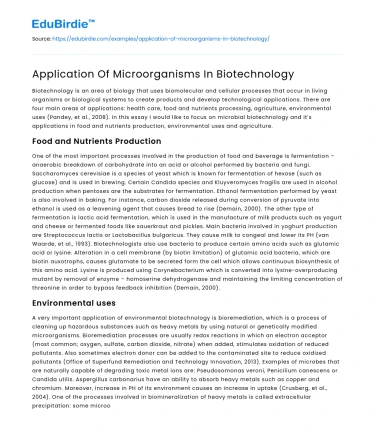Biotechnology is an area of biology that uses biomolecular and cellular processes that occur in living organisms or biological systems to create products and develop technological applications. There are four main areas of applications: health care, food and nutrients processing, agriculture, environmental uses (Pandey, et al., 2008). In this essay I would like to focus on microbial biotechnology and it’s applications in food and nutrients production, environmental uses and agriculture.
Food and Nutrients Production
One of the most important processes involved in the production of food and beverage is fermentation – anaerobic breakdown of carbohydrate into an acid or alcohol performed by bacteria and fungi. Saccharomyces cerevisiae is a species of yeast which is known for fermentation of hexose (such as glucose) and is used in brewing. Certain Candida species and Kluyveromyces fragilis are used in alcohol production when pentoses are the substrates for fermentation. Ethanol fermentation performed by yeast is also involved in baking. For instance, carbon dioxide released during conversion of pyruvate into ethanol is used as a leavening agent that causes bread to rise (Demain, 2000). The other type of fermentation is lactic acid fermentation, which is used in the manufacture of milk products such as yogurt and cheese or fermented foods like sauerkraut and pickles. Main bacteria involved in yoghurt production are Streptococcus lactis or Lactobacillus bulgaricus. They cause milk to congeal and lower its PH (van Waarde, et al., 1993). Biotechnologists also use bacteria to produce certain amino acids such as glutamic acid or lysine. Alteration in a cell membrane (by biotin limitation) of glutamic acid bacteria, which are biotin auxotrophs, causes glutamate to be secreted form the cell which allows continuous biosynthesis of this amino acid. Lysine is produced using Corynebacterium which is converted into lysine-overproducing mutant by removal of enzyme – homoserine dehydrogenase and maintaining the limiting concentration of threonine in order to bypass feedback inhibition (Demain, 2000).
Save your time!
We can take care of your essay
- Proper editing and formatting
- Free revision, title page, and bibliography
- Flexible prices and money-back guarantee
Environmental uses
A very important application of environmental biotechnology is bioremediation, which is a process of cleaning up hazardous substances such as heavy metals by using natural or genetically modified microorganisms. Bioremediation processes are usually redox reactions in which an electron acceptor (most common; oxygen, sulfate, carbon dioxide, nitrate) when added, stimulates oxidation of reduced pollutants. Also sometimes electron donor can be added to the contaminated site to reduce oxidized pollutants (Office of Superfund Remediation and Technology Innovation, 2013). Examples of microbes that are naturally capable of degrading toxic metal ions are: Pseudosomonas veroni, Penicilium canescens or Candida utilis. Aspergillus carbonarius have an ability to absorb heavy metals such as copper and chromium. Moreover, increase in PH of its environment causes an increase in uptake (Crusberg, et al., 2004). One of the processes involved in biomineralization of heavy metals is called extracellular precipitation: some microorganisms (f.e. Penicillium ochro-chloron) produce Oxalate and Sulfide anions which form insoluble salts with heavy metal ions. Ralstonia picketti is capable of degrading aromatic hydrocarbons (benzene, toluene, phenol) which are carcinogenic and can be found in ground water and soil. R.picketti uses hydrocarbons as an energy source. This is done via multi-enzyme pathways: Tbu pathway converts hydrocarbons into catechols (Ryan, et al., 2007). In order to increase growth and tolerance to PH variations and extreme conditions of microorganisms, genetic engineering has to be applied. As an example, strains of Deinococcus geothermalis have been genetically modified to resist very high temperatures while decontaminating environment polluted with radioactive waste (Luciene, et al., 2015).
Agriculture
Agricultural biotechnology aims to improve health and nutritional quality of the crops, develop resistance to pests and diseases, increase livestock productivity and also create vaccines. To promote plant health without using chemical fertilizers scientists introduced microbial inoculants – microorganisms that interact with plants and serve as biofertilizers, protect against pathogens and stimulate plant hormone production. (Bashan & Holguin, 1997). There are four different methods for microbial inoculation of seeds: 1. Seed soaked in inoculant, 2. Thin inoculant layer on seed surface, 3. Inoculant in carrier stuck to the seed, 4. Inoculant plus other additives applied to the seed (O'Callaghan, 2016). Capabilities of microbial inoculants are used in agricultural application called biocontrol. Bacteria known as biological control agents are usually different species of Bacillus and Pseudomonas. Many strains of Pseudomonas fluorescens are able to colonize plant’s rhizosphere at very high density and produce antifungal metabolites such as 2,4 – diacetylphloroglucinol (Phl). Pseudomonas producing Phl can also induce systemic disease resistance in plants. Examples of crops that can be treated with P.fluorescens are: potatoes, apples, tomatoes, blueberries, cherries, almonds (Mark, et al., 2006). Bacillus spp. have been proven to benefit cowpea seed germination and yield parameters by anti-fungal activity, phosphorus solubilisation. Biocontrol also allows the protection of crops from invertebrate pests. Microbial agents are applied to the rhizosphere of a plan. Serratia entomophila is an insect pathogen that is commercially used against the New Zealand’s grass grub - Costelytra zealandica, which larvae causes big economical losses (O'Callaghan, 2016).
Application of microorganisms in biotechnology is essential for a wide range of processes involved in production, maintaining sustainability of the environment and improvement of new technologies. Microbes have a major influence in food and nutrients production sector. Fermentation is one of the most important processes in production of dairy and alcohol. Furthermore, the use of microorganisms as bioremediation agents is helping to fight environmental pollution by removal of hazardous substances from aqueous solutions. To improve effectiveness of agriculture, biotechnologist involve microorganisms in seed planting and crops maintenance. Using microbes instead of pesticides helps the environment and increases plant growth, survival rate and health.






 Stuck on your essay?
Stuck on your essay?

